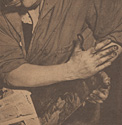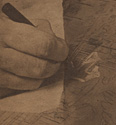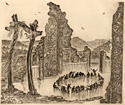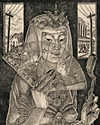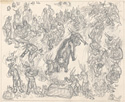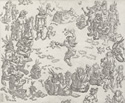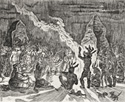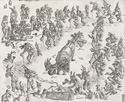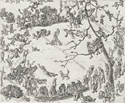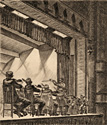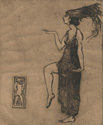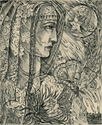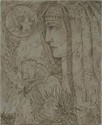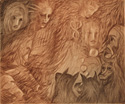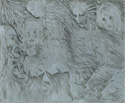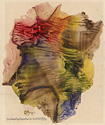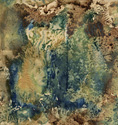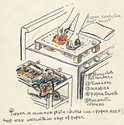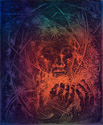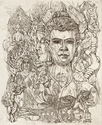This exhibition is dedicated
to Rev. Joseph A. Haller, S.J. (1920 – 2008)
and Helen King Boyer
Introduction
Mother-daughter printmakers Louise Miller Boyer (1890 – 1976) and Helen King Boyer (b. 1919) began their careers in 1930s industrial Pittsburgh. The women were first introduced to printmaking through a close relationship that husband/father Ernest W. Boyer had developed with key figures at the Aluminum Company of America (Alcoa).
While the Boyer women’s works have interchangeable aesthetic themes, each deserves dedicated study. Louise Miller Boyer received her training in illustration and design from the Carnegie Institute of Technology (now Carnegie Mellon University). She always saw Pittsburgh as the quintessential city: a hybrid of industry, suburbia, and culture. Her love for her home city is seen in the series of prints that bear its name.
Helen Boyer’s work was more introspective, drawn from childhood and experiences living through the Depression and World War II. A sickly child bedridden during her youth, Helen Boyer spent her early years in a lonely room with dance magazines, crafts, and dolls as sources of entertainment. Her father would read her classic literature by Dickens, Thackeray, and Shakespeare. Helen Boyer later commented that she always felt a clear plate glass window separated her from the world.
Although the Boyer women approached their themes differently, what united them was their innovative choice of materials, specifically the printmaking plate itself. Working on anodized aluminum plates supplied by Alcoa, Louise Boyer found this bonded surface could run through the press multiple times without affecting the design, unlike traditional zinc or copper plates. Its super-hard surface also facilitated the intricate, detail work the Boyers excelled at.
This exhibition focuses on the Boyers’ technical innovations as well as their psychological connection to Pittsburgh. Although they moved to various cities throughout their lives, the Boyer women looked at their years in Pittsburgh as a major turning point from amateur printers to innovative printmakers. The essence of the industrially-urbanized Pittsburgh, the cultural impact of Alcoa, and the events that took place during the mid-twentieth century live on in the Boyer women’s aluminum plates.
Louise Miller Boyer: The Pittsburgh Experience
Louise Miller Boyer (1890 - 1976) was born and raised in Pittsburgh, Pennsylvania. Daughter of artists, Boyer was initially interested in becoming a writer but was persuaded to paint and draw at an early age. In 1913 she was among the first graduating class of the School of Applied Design at Carnegie Institute of Technology (now Carnegie Mellon University) with a degree in painting and design. While at Carnegie Tech Boyer met her future husband, noted Pittsburgh architect Ernest W. Boyer. Both were quite active members in the Pittsburgh arts community. She later returned to Carnegie Tech and the University of Pittsburgh for further study in art history and technical courses. She spent time in Europe studying iconography and religious art and worked on illuminated manuscripts. Her professors included artists Henry Keller, Arthur Sparks, and Charles Hawthorne.
In 1931, Aluminum Company of America (Alcoa) opened in Pittsburgh. Mr. Boyer was invited to work at Alcoa as an architect. Among his circle were architect Pierre Hogner, printing press designer Paul Schwan and artist Edward Trumbull, who gave the Boyers their first press. Mr. Boyer’s relationship with these print enthusiasts introduced Louise to various printmaking methods. Both Schwan and Mrs. Boyer began giving print demonstrations on miniature presses for school children in the Pittsburgh area and discovered that anodized aluminum plates were ideal because unlike copper or zinc plates, they didn’t require the use of chemicals and were safer around children. After much experimentation, Mrs. Boyer discovered that the durable aluminum plate was best suited to drypoint rather than etching because it was easy to cut into and allowed for multiple print editions.
Monastery Hill (Pittsburgh no. 3)
Louise Miller Boyer
Drypoint
328 x 379 mm
The monumentality evoked in Monastery Hill establishes Louise Boyer’s illustrative trademark. Though the outskirts reveal the everyday activities of suburban Pittsburgh citizens, Boyer contrasts the dramatic aerial view with a glimpse of industrial Pittsburgh in the backdrop. This print from the Pittsburgh Series best exemplifies Boyer’s involvement with American Scene Regionalism. During the 1930s and 1940s, no motif was as popular as American rural life. Although Boyer is highly influenced by American Regionalist artist Thomas Hart Benton, she juxtaposes the subtle intimacy with the rawness of industrialization represented through the steel and coal factory smoke chains. Both rural and urban lifestyles are connected through the notable bridges of Pittsburgh.
Snowshroud (Pittsburgh no. 1)
Louise Miller Boyer
Drypoint; 1st impression
140 x 203 mm
Snowshroud is Louise Boyer’s first successful impression printed from an aluminum plate. It would be the first of twenty-two aluminum drypoints in the Pittsburgh Series. These prints serve as a record of industrial life along the banks of Pittsburgh’s Monongahela River—its mills, laborers, and their houses. Louise Boyer once said, “I think Pittsburgh is the most complex and dynamic city in America.”
Bennett’s Barn
Ernest W. Boyer (1885 – 1949)
Etching on copper; State II. Ed. 23
106 x 150 mm
Ernest W. Boyer trained in architecture at Carnegie Institute of Technology where he met future wife Louise Rive-King Miller. Ernest Boyer held memberships in the Pittsburgh Architectural Club and the American Institute of Architects. He took up printmaking after meeting artist Edward Trumbull. Ernest Boyer never set out to be a professional printmaker; rather, he used his prints as exercises before drawing his scaled buildings. Bennett’s Barn is an example of Boyer’s interest in infrastructure and landscape.
Fireman’s Carnival (Pittsburgh no. 16)
Louise Miller Boyer
Drypoint; 6/50. State II
201 x 276 mm
Fireman’s Carnival provides a unique perspective into the Pittsburgh Series. While the other prints focus on the interaction between architecture, industry, and leisure activity, Fireman’s Carnival emphasizes Pittsburgh summer nightlife. Boyer’s illuminated atmosphere is evoked through deep contrasts between lights and darks created by areas of carefully selective cutting of the plate.
Taylor at 19 (as Peer Gynt)
Louise Miller Boyer
Drypoint
213 x 139 mm
As well as scenes of Pittsburgh, Louise Boyer is noted for her eloquent portraits which capture the individual personalities of the sitter. Boyer’s training in illustration contributed to her exceptional figural draftsmanship. Her appeal to people brought portrait commissions. These prints depict Boyer’s children Taylor and Helen. The image of Taylor is one of two individuals Louise Boyer used as part of her Peer Gynt suite displayed along the north wall of the exhibition.
Hot Mill (First Line of Defense) (Pittsburgh no. 14)
Louise Miller Boyer
Drypoint; 1/29
213 x 139 mm
This print was one of two Boyer prints featured in the Artists for Victory exhibition held at the Library of Congress in 1983, depicting America during World War II. Curator Ellen G. Landau commented that the print “attests to the strong feelings Louise Boyer had about the steel industry in her native Pittsburgh and to her conviction about the importance of the work done by American industry in helping to win a global war.”
Taylor Miller Boyer, Helen King Boyer, Louise Miller Boyer at the press
Photographer unknown
Photograph reproduced from The Pittsburgh Press
Deer
Louise Miller Boyer
Drypoint
110 x 85 mm
This set of miniature prints are some of the many produced as greeting cards for mass distribution. Louise Boyer was commissioned by Alcoa to make multiple impressions to be given out at public events and mailed to editors at local Pittsburgh advertising firms. It is not uncommon for printmakers to send small prints as greeting cards to friends.
Johnnie Appleseed Past [sic] Here (Pittsburgh no. 22)
Louise Miller Boyer
Drypoint; 3/25. HKB 1976 Impression. Last print signed by the artist.
277 x 214 mm
The Pittsburgh Series not only provides scenes of recognizable landmarks but also a narrative quality. Johnnie Appleseed, the last in the series, is a welcoming look into the artist’s life. The Boyer family house is depicted in the background. However, it is the apple tree that dominates the print’s foreground. According to family legend, pioneer gardener Johnny Appleseed, who visited Pittsburgh during his missionary trip into the American frontier, planted an apple tree in the Boyer’s backyard.
Louise Miller Boyer tracing onto the plate
Photographer unknown
Photograph reproduced from The Pittsburgh Press
Louise Miller Boyer cleaning a plate
Photographer unknown
Photograph reproduced from The Pittsburgh Press
Helen King Boyer: The Gap Between Art & Life
Helen King Boyer (b. 1919) was bedridden during the first ten years of her life due to a failure of her lymphatic system at age four. Since she wasn’t able to attend grade school her father, Ernest W. Boyer, read to her literary classics from Dickens, Shakespeare, Stevenson and Thackeray. She also entertained herself with coloring books and drawing materials, weaving, construction paper cut-outs, and by flipping through the pages of dance magazines from the early 1900s.
Helen Boyer’s artistic training came not from the classroom but on personal observation and retentive memory. She spent hours closely studying the anatomy of her various toy figurines. As the daughter of etchers who had a printing press at home, she taught herself that process by age fifteen. A year later she had her first solo show at the Gulf Building in Pittsburgh.
Although she never formally enrolled in college, Helen Boyer took courses at Carnegie Tech and the University of Pittsburgh. Her professors included artists Samuel Rosenberg and Joseph Bailey Ellis. During the 1930s and early 1940s she and her mother experimented with anodized aluminum plates in Pittsburgh, working closely with Alcoa. During that time Helen Boyer also found work in the advertising department at the Pittsburgh Telegraph. In 1949, Helen Boyer received a Tiffany Foundation grant and moved to New York City with her mother, where she refined the new aluminum printmaking medium. She also found work as a designer of tie silks and stuffed toys. The Boyers would permanently relocate to Kansas City, Missouri in 1961, where both artists took classes at the Nelson-Atkins Museum of Art and were active members in the Art Association of Greater Kansas City.
Peace Table II “For they shall build the old wastes”
Helen King Boyer
Drypoint; 15/50
188 x 214 mm
The print and watercolor for Peace Table II are two of several works made during the 1940s which comment on America’s involvement in World War II. In her Nov. 13-14, 1984 oral interview with the artist, Helena Wright, Curator of Graphic Arts at the Smithsonian’s National Museum of American History noted that Ms. Boyer’s works from this period “are the strongest in satirical comments because [she] provides an edge to observation in war related prints.” The title is taken from a verse in the Bible. The artist alludes to past world conflicts amongst nations and their ultimate demise. The silhouetted figures, set against a crumbling wall depicting past civilizations and present dictatorship power (Hitler within the stained glass), argue for peace in the foreground.
Peace Table I “The Seven Deadly Sins”
Helen King Boyer
Drypoint; trial proof, 3rd edition
190 x 227 mm
These two wartime prints reflect on communication. In Rumor the artist refers to Tokyo Rose, a generic name given to female broadcasters of Japanese propaganda. The jewels around her neck are chiseled with seals representing labor unions, organizations, and the Papacy. Her alluring monarchical looks deceive her viewers and listeners. The initials S.A.E. at the bottom right denote the artist’s membership in the Society of American Etchers. American etcher John Taylor Arms, then president of the society, frequently corresponded with the Boyers, who were both admitted in 1943.
Peace Table I shows individuals gathered at a table, each representing a country involved in the war. Uncle Sam sits with one arm holding his head as he listens. Byōbu (Japanese folding screens) block their meeting from the outside world. Each panel illustrates one of the seven deadly sins, and reflects the mixed emotions expressed by the differing political, social, and economical viewpoints of each nation.
Society of American Etchers acceptance letter
John Taylor Arms to Louise Miller Boyer and Helen King Boyer
275 x 185 mm
Sacre du Printemps
Helen King Boyer
Drypoint
107 x 139 mm
As a child, Helen King Boyer spent hours looking through magazine pictures of dance performances, especially those of the Ballets Russes. She was fascinated with the company’s choreography and music. In her early years Helen Boyer designed costumes for her dolls inspired by various ballets. This print is the first concept in Boyer’s Sacre du Printemps suite, made when the artist was only thirteen years old. The second image shows the back side of the aluminum printing plate, where Helen made some preliminary ballet-focused sketches that were later discarded in favor of a richer narrative approach.
Sacre du Printemps Suite
Helen King Boyer
Drypoint
113 x 138 mm each
I. The Dance of Death, 1942
II. Evocation of the Ancestors, 1943
III. Sacrifice to the Earth, 1943
IV. Games of the Rural Village, 1945
Le Sacre du Printemps (The Rite of Spring) premiered in Paris in 1913 with music by legendary composer Igor Stravinsky and choreography by Vaslav Nijinsky. Helen Boyer created a set of four prints, each portraying an iconic scene from the ballet. These prints are at times satirical in the artist’s caricatured portrayals of the primitive inhabitants. However, they also serve as childhood synesthetic nostalgia. In 1930 the U.S.-staged version of Le Sacre du Printemps opened in Philadelphia under Leopold Stokowski’s direction with modern dance pioneer Martha Graham performing the principal role of the sacrificial virgin.
The Rehearsal
Helen King Boyer
Drypoint; 18/50. Kansas City 1978 edition
137 x 119 mm
The Boyer women spent much of their time attending various performances in the vibrant Pittsburgh cultural scene. Helen Boyer portrays the composer Fritz Reiner and the Pittsburgh Symphony at the Syfia Mosque. Helen Boyer draws her musical inspiration from Stravinsky, Bach, and Mozart.
Plate for Tuning (Harpist)
Helen King Boyer
Aluminum printing plate
113 x 80 mm
The drypoint needle allows the artist to delicately draw the harp’s strings, which evoke the instrument’s musical score.
Du Holde Kunst
Helen King Boyer
Drypoint; 26/50
212 x 265 mm
Du Holde Kunst is a complex multilayered print. The title refers to Austrian composer Franz Schubert’s romantic German song An die Musik (To Music). The hymn is to the art of music, but Helen Boyer does not create a scene that alludes to harmonious notes. Instead she depicts a lonely woman, outside by a tree during a frigid winter snow storm. She is wrapped in a cloak and her eyes are closed. The print is also autobiographical. Franz von Schober wrote a poem that accompanied Schubert’s music. He looks at music being the quintessential transcendental experience from the everyday world. For Helen Boyer, the arts were her escape during the years of her childhood illness and growing up during the Depression.
East of the Sun
Helen King Boyer
Drypoint; 7/50. Kansas City 1984 impression
212 x 265 mm
Captivated by classic literature, East of the Sun alludes to the Norwegian folk tale East of the Sun and West of Moon. In 1914, popular Danish illustrator Kay Nielsen provided 25 color plates for a newly published edition. Nielsen (1886 – 1957), a seminal artist from the “Golden Age” of illustration, was influenced by Asian art, Japanese color woodblock prints, and British artist Aubrey Beardsley. Helen Boyer reinterprets East of the Sun by designing a two-colored Asian-inspired plate that plays on the tale’s title and illustrator.
Alcoa, Innovation, & Beyond
The Boyer women began printing their aluminum plates in the early 1930s in Pittsburgh. Noted Alcoa architect and engineer Pierre Hogner introduced the anodized aluminum plates to Louise Boyer as a substitute for traditional copper and zinc matrices. Using anodized aluminum plates eliminated the need for the ground coating used on copper or zinc plates, as well as the immersion in acid required to carve out the etched lines on plates of those metals. Most importantly, aluminum was lightweight, durable, flexible, and inexpensive. Hogner, who patented the aluminum printing plate in 1937, proposed “if an aluminum or aluminum alloy plate… is provided on its surface with a suitable aluminum oxide coating and the desired design is subsequently produced thereon, the difficulties heretofore encountered are minimalized.” The anodized coating was simply created by immersing the aluminum plate into an electrolyte bath, where oxygen ions were released to combine with aluminum atoms to produce a surface that is pure and hard. Thus the specially coated plate could withstand several runs through the press without affecting the design.
For the Boyer women drypoint was the preferred and suitable printing method on aluminum. Areas of lights and darks were achieved by adding or decreasing pressure onto the needle. The overall effect was a narrative, ornate impression. As this wall demonstrates, a simple needle, jewelry pick, or needle dart allowed for the most intricate and delicate details. Later in their careers, Louise and Helen Boyer would experiment with other printing media. Aquatints and encaustic monotypes seen here illustrate how the Boyers transformed their past motifs into looser, non-linear forms.
Henry Harris, Pianist
Louise Miller Boyer
Etching on aluminum; Trial proof
215 x 180 mm
These two prints are examples of Louise Boyer’s early experiments in printmaking. Erma Seibal is Louise Boyer’s attempt at traditional etching. She portrays a woman, believed to be a ballet dancer, whom the artist must have seen in Pittsburgh. Over a decade later, Alcoa architect and engineer Pierre Hogner introduced anodized aluminum plates to the Boyer women. Henry Harris was first executed by scratching into the anodized surface and then putting it into the acid bath. However the results were unsuccessful. The aluminum plate became uneven after a run through the press and the image was unsatisfactory.
Demeteric Cycle (shown with plate)
Helen King Boyer
Drypoint; 16/50
138 x 113 mm
Many of the Boyers’ prints draw influence from classical mythology. Helen Boyer examines Demeter, goddess of the harvest. After her daughter Persephone is taken away by Hades into the underworld, Demeter seizes agricultural growth. This print focuses on Demeter and the seasonal changes throughout the year. The artist has carefully structured overlapping elements to convey the various climates. The drypoint needle is able to write out words on the plate. Here, the artist includes a verse along Demeter’s veil.
Orpheus in the Underworld (shown with plate)
Louise Miller Boyer
Drypoint; HKB impression
138 x 113 mm
Louise Boyer looks at the tragic tale of Orpheus and Eurydice. After being bitten by a venomous snake, Orpheus takes Eurydice’s dead body into the underworld and through his music convinces Hades and Persephone to bring his wife back to life. The artist’s loose-hand use of the needle shapes the print’s figures but also designs the fiery depths of Hell.
Siddhartha Searches for His Identity
Louise Miller Boyer
Encaustic monoprint over-worked with sgraffito and solvent
250 x 205 mm
Louise Boyer did not rely on the spontaneity of the melted wax crayon to form her images. As Helen Boyer comments, “[Mother] took the accidental out of her prints. She came up with multiple plates shaped to her will.” Here, the artist paid close attention to the many faces that Siddhartha will meet before achieving enlightenment. (Siddhartha is the spiritual teacher on whose teachings Buddhism was founded.)
Europa and the Bull
Helen King Boyer
Encaustic
110 x 230 mm
Later in their artistic careers, the Boyer women experimented with other printmaking techniques on their aluminum plates. Around 1970 the Boyers began their encaustic monoprints (an image that can be printed only once) in Kansas City, Missouri. Inspired by Rorschach inkblot tests that were popular during the 1960s amongst psychologists, the Boyers used waxed colors drawn on a flat metal hot plate and transferred the image to glossy paper.
The Boyers had frequent demonstrations on encaustic printmaking in their own kitchen. Members from the community and various arts organizations joined the Boyers in producing unique miniature impressions. They preferred simple, everyday materials such as blank pages for collecting stamps, and children’s crayons.
Light from Darkness
Helen King Boyer
Aquatint. Printed black/over roll color; 5/7. Alfred Gay impression, Seattle
552 x 452 mm
This aquatint is one of several versions in the Georgetown Art Collection. Similar to traditional etching, this technique uses acid to create marks on the plate. But instead of using a needle to make lines, aquatint uses powdered resin that is acid resistant on the metal to make tonal effects. For this print, one blank plate was painted with sweeps of multiple colors, and then a second plate containing the image was printed in black. The end result is a luminous and arresting image.
Some Stars and Two Atoms
Helen King Boyer
Drypoint; 3/50
213 x 138 mm
Helen Boyer never identified with a specific religious denomination. However she was an avid reader of the Bible and other spiritual texts from different cultures. She looks at ideas on Creationism, as seen in this print. The artist combines a stippling and organic composition with the drypoint needle to create an illuminating theatrical setting.
A Printmaking Team
The Boyer women’s artistic careers extend over thirty years. Although their works are distinguished by aesthetic differences, the Boyers are best understood by exploring the collaborative aspects of their careers.
Louise Boyer’s academic training and relationship with Alcoa gave her the intellectual tools to comment on Pittsburgh’s development into an industrially urbanized city. Helen Boyer, on the other hand, mined her own life’s experiences and struggles to produce a personal narrative. Yet the Boyers share many thematic interests: the visual and performing arts, literary references, mythology and spirituality, for example. Most significant for them was their psychological connection to Pittsburgh. The Pittsburgh years of the 1930s and 40s saw the Boyers develop from amateur printers into innovative printmakers.
For the Boyers, prints were the ideal medium for communicating with others. Louise Boyer began by giving classroom printmaking workshops in the early 1930s in New Kensington, PA; Helen Boyer later followed in her mother’s footsteps. The Boyer women often worked as a mother-daughter printmaking team. In Kansas City, Missouri, the Boyers were active members in the Village Printmakers Guild, having joined after taking classes at the Nelson-Atkins Museum of Art. They participated in the Guild’s annual Renaissance Art Festival where they gave demonstrations and community members were able to make their own prints.
Transmigration
Helen King Boyer
Drypoint; 2/50. Kansas City edition. HKB impression 6/14/79
265 x 212 mm
This print features a physical and mental presence related to the artist’s personality. As seen on the south wall of the exhibition, the Boyer women were well-versed in world religions and beliefs. They spent hours at the Nelson-Atkins Museum of Art in Kansas City observing non-western artwork. Asian art exhibition catalogues and The Tale of Genji would motivate the Boyers to produce prints observing eastern motifs. In this print, Helen Boyer narrates the story of Buddha and molds the stages of his transmigratory enlightenment into one cohesive composition.
Sea Change II
Helen King Boyer
Drypoint; State II
213 x 150 mm
This set of prints invites the viewers into the Boyer women’s personal lives. Helen at 12 is an early example of Louise Boyer’s use of drypoint on aluminum. Simple contours form the reclining body of the artist’s daughter while she reads a book. Most of the artist’s efforts are placed on Helen’s pensive expression.
Sea Change II refers to Ariel’s song in Shakespeare’s The Tempest. Helen Boyer portrays herself as Ariel, looking dazzlingly into the abyss. Hovering above her are several thinly shaped sea-nymphs who are transforming a skeletal figure into coral. The vertical lines created by the drypoint elevate the surreal, transcendental atmosphere; it seems as if the figures are submerging into the waters of the deep-dark sea. The artist holds an open book with a skeletal figure reaching over to her left hand. There are clear links between the artist’s fascination with literature but also her years of physical and mental absence from others.
Tam Tam
Helen King Boyer
Etching
Popular culture played a pivotal role in the Boyers’ work. Tam Tam is Helen Boyer’s tribute to the great American performer Josephine Baker. Dance and music is perceived by the playing of the drums in the foreground.
Anitra’s Dance
Louise Miller Boyer
Drypoint; HKB impression, 1986
215 x 145 mm
Louise Boyer created the Peer Gynt Suite as an entry to a local arts competition. This suite of prints presents several scenes from Henrik Ibsen’s Norwegian play. The centrally placed figure of Arabic princess Anitra dances sensually before the disguised Peer Gynt.
Waterfront
Louise Miller Boyer
Drypoint; 3/4. 2nd edition, HKB impression, Kansas City
139 x 201 mm
The Boyer women created a visual psychology with their prints. Although they moved to Maryland, New Jersey, New York and finally Missouri, their hearts always remained in Pittsburgh. In Waterfront Louise Boyer juxtaposes the rawness of the coal industry with the contours of three gigantic men working on a steel bridge. The artist is commenting on the relationship between man, machine, and American urbanization.
Helen Boyer also draws on leisure activity with her nautically-themed drypoint. The striking perspective allows the viewer to zoom in on the steamboat’s captain who stands casually as he awaits individuals to board a trip down one of Pittsburgh’s famous rivers.
The Old Mellon Bank, Pittsburgh
Louise Miller Boyer with Helen King Boyer
Etching on copper, States I and II (both LMB impression)
276 x 188 mm and 232 x 150 mm
The Old Mellon Bank states I and II are prime examples of how the Boyer women worked together as a mother-daughter printmaking team. The Boyers were commissioned to etch an image for a brochure for the Mellon Bank. Louise Boyer designed the building’s facade and Helen Boyer etched the figures and chariot in the foreground. However, as we see in the second state of the print, the Boyers were asked to remove the people because the client decided to concentrate on the building’s architectural and commercial significance.
Alfred Acres, Associate Professor of Art History, Georgetown University
Archives of American Art, Smithsonian Institution
Albert “Scip” Barnhart, Studio Art Lecturer & Master Printmaker, Georgetown University
Helen King Boyer
Carnegie Mellon University Libraries
Dailey Family Endowment for Research in Art & Art History
Melodie & Greg Foreman
Georgetown University Department of Art & Art History
Georgetown University Special Collections Research Center
DeAnna Martin & Robert Blanc
Akemi May, Curatorial Assistant, Department of Fine Arts, Carnegie Museum of Art
The Metropolitan Museum of Art
Elizabeth Prelinger, Keyser Family Professor of Art History, Georgetown University
Veda and Bruce Rogers
Rachel Sadvary, Assistant to the Registrar, Carnegie Museum of Art
Nicholas Scheetz, Manuscripts Librarian, Special Collections Research Center, Georgetown University
Christine Slippy, Research Librarian, Alcoa Technical Center
Linda Smith
Scott Taylor, Manuscripts Processor, Special Collections Research Center, Georgetown University
LuLen Walker & Christen Runge, University Art Collection, Georgetown University
Brandt Witt & Family
Amanda T. Zehnder, Associate Curator of Fine Arts, Carnegie Museum of Art
About the Guest Curator
Marvin J. Aguilar is a senior in Georgetown College majoring in Art History. This exhibition is based on his Senior Thesis, The Boyer Family: Mother-Daughter, Innovative Printmakers. Marvin works as a student assistant in the Special Collections Research Center, and is also a member of the university’s Men’s Varsity Lightweight Crew Team.
About the Collection
The Boyer Collection’s approximately 400 prints, drawings, and other works of art including drypoint aluminum plates, was donated in 1987 by Helen King Boyer in memory of her parents, Ernest W. Boyer and Louise Miller Boyer. The collection is further augmented by 8.50 linear feet of the family’s correspondence dating from ca. 1823-1940. The Smithsonian Institution’s National Museum of American History also holds a large collection of Boyer prints and aluminum plates.

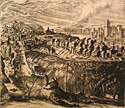







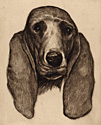

![Johnnie Appleseed Past [sic] Here (Pittsburgh no. 22)](/sites/default/files/images/boyer__011_t.jpg)

